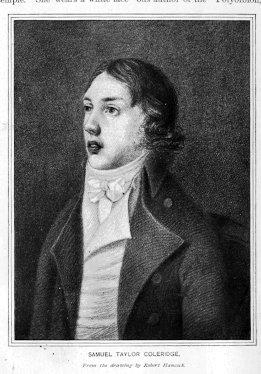Coleridge & Newton
Today, Romantic poets set the stage for Victorian science. The University of Houston's College of Engineering presents this series about the machines that make our civilization run, and the people whose ingenuity created them.
Here's an odd letter by the poet Coleridge. He's 29 and writing to his friend Tom Poole. " ... deep Thinking," he says,
is attainable only by a man of deep Feeling ...
all Truth is a Species of Revelation.
He goes on to say he's been studying Newton. It's hard going, but he's "delighted with the beauty and neatness of [Newton's] experiments." He also likes Newton's "immediate deductions." Then he gets to the point. Newton's overall vision, he says, is "so superficial." In Newton's system, the mind "is always passive -- a lazy onlooker on an external world."
The year was 1801. For over a century, Newton had set the Rationalist agenda. It was clear enough to Coleridge that Newton was shaping the objective scientific method we use today. Scientists and science-based engineers have struggled ever since to view an external world with objective detachment.
Coleridge wanted none of that. He went on to say that the human mind is the creative wellspring. We misuse the mind when we make it into a passive observer of an external world
The earliest Romantic poet, William Blake, had already said the same thing. "I will not reason and compare," he vowed. "My business is to create." The same year Coleridge wrote his letter, Blake wrote this:
The Atoms of Democritus
And Newton's Particles of light
Are sands upon the Red sea shore.
When those 19th-century thinkers attacked Rationalism, their impact on the world of making and doing was profound. Science went into retreat while a technology like none ever known rose up in England. Machines, of course, are the first fruit of the human mind. Before a machine can be built in the world, it must be built in the mind. It is a synthetic reality. Technology acts out the Romantic vision.
So English engineers flung their railroads, iron bridges, and steam factories across the land, and Wordsworth wrote,
Huge and mighty forms that do not live
Like living men, moved slowly through the mind
By day, and were a trouble to my dreams.
Formal Newtonian science came back in the late 19th century. But it came back as a powerful set of man-made models of the external world. We've never seen scientific success to match that of the late 1800s. Victorian science was based on Newtonian rigor, all right. But the Romantic thinkers had given it a new dimension. Victorian science went so far because it gazed on the world within -- before it gazed on the world around us.
I'm John Lienhard, at the University of Houston, where we're interested in the way inventive minds work.
(Theme music)
Jennings, H., Pandaemonium, 1660-1886. New York: The Free Press, Macmillan, Inc., 1985.

From Scribner's Magazine, September, 1896